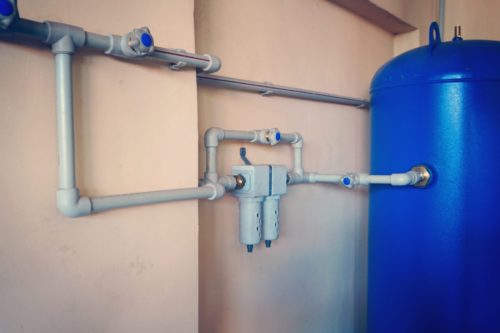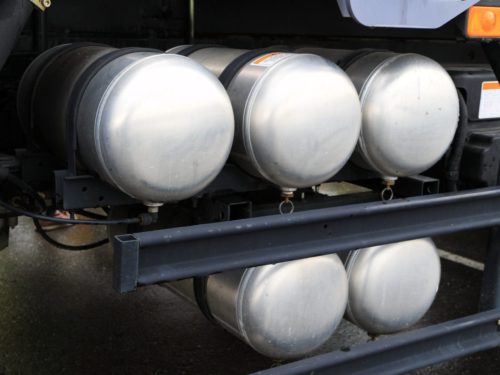There are many benefits to having compressed air on reserve in an industrial air receiver tank. Before you decide if you need one, it’s essential to understand how they work and improve the efficiency of your entire system.
Compressed Air Receiver Tanks
 An air compressor receiver tank is designed to hold compressed air until you need it, so you can avoid running the compressor for short-term demands. It’s usually made of mild steel, and the outside of the tank may be primed to prevent corrosion and increase longevity. Specialty applications, such as medical or food and beverage, may require a galvanized or epoxy-coated tank interior, or the tank material can be made of stainless steel. Though more expensive, they’re even more durable and offer a higher level of air purity.
An air compressor receiver tank is designed to hold compressed air until you need it, so you can avoid running the compressor for short-term demands. It’s usually made of mild steel, and the outside of the tank may be primed to prevent corrosion and increase longevity. Specialty applications, such as medical or food and beverage, may require a galvanized or epoxy-coated tank interior, or the tank material can be made of stainless steel. Though more expensive, they’re even more durable and offer a higher level of air purity.
Depending on your space, high pressure air receiver tanks can be mounted horizontally or vertically. They’re available in many sizes and are typically cylindrical, though certain specialty applications may call for a different tank shape.
Pressurized air can pose an immense safety hazard, so it’s important to choose a tank that has been certified by the American Society of Mechanical Engineers. This ensures it meets the standards for safety and quality.
The Purpose of an Air Receiver Tank
As part of your compressed air system, this reserve tank does more than store compressed air for on-demand access. It also reduces the workload on your compressor controls, since you don’t have to use the compressor for every small need. Reducing the number of these on/off compressor cycles increases the lifespan of your motor, the switches, and other components.
Finally, the tank can act as a secondary heat exchanger. Pressure causes air temperature to rise—it can be as hot as 350° F when it leaves the compressor, which is way too hot for many applications. Further, the hot air is wet; that humidity can cause problems in control lines and other equipment.
Since the air stays in the compressed air reservoir before it’s used, it has time to cool down naturally by up to 10° F. That’s not cool enough for use, but it is enough to lower the demand on your primary heat exchanger, helping you save energy and prolong the life of your heat exchanger.
How Compressed Air Receiver Tanks Work
There are two primary types of compressed air storage: wet and dry. The tanks are essentially the same; the difference is where they’re installed within the system.
- Wet Tanks: These are installed before the dryer and are common in systems that deal with high humidity. Because the storage tank cools and dries the air slightly, it reduces the workload on your dryer and filter by removing the cooled water. The water is then removed by a condensate drain located at the bottom of the tank.
- Dry Tanks: These are installed after the dryer, so the air has already been dehumidified before it reaches the industrial air receiver tank. The stored air is ready to use on demand, which is helpful in preventing surges in fast compressor cycles. It is also recommended that a condensate drain is installed at the bottom of the tank for the small amount of water that will accumulate.
Common Uses for Compressed Air Receiver Tanks
 For short-duration compressed air needs, using stored air is easier on your system. These uses include:
For short-duration compressed air needs, using stored air is easier on your system. These uses include:
- Inflating tires
- Running air-powered tools
- Operating pneumatic cylinders or pistons
- Sand- and shot-blasting
- Painting
- Cleaning
- Operating conveyor systems
- And more
Maximize Efficiency in Your Compressed Air Receiver System
Every time you operate the compressor, you lose some compressed air via the venting of the sump tank. It may seem like a small loss, but think of all the cycles your compressor goes through in a work day: it adds up.
If you’re not using stored air, your system is always operating at a high pressure to meet high demand, whether you need it or not. The storage tank levels the demand peaks and reduces pressure on the entire system.
As mentioned above, the air compressor receiver tank aides your air dryer by functioning as a secondary heat exchanger. As the air cools, the excess moisture drains through a valve; by the time the air gets to the dryer, it’s cooler and lighter, which eases the dryer’s workload. It all adds up to more energy savings and longer-lasting equipment.
Sizing a Compressed Air Receiver
The rule of thumb in sizing the correct air receiver is two times the rated compressor SCFM for a Variable Speed Drive compressor and three times the rated SCFM for a fixed speed or load/no-load compressor. As an example, a 100 SCFM rated fixed speed compressor would require a 300 gallon air receiver. There are different schools of thought in selecting an air receiver and the above rule-of-thumb is a simple guideline. But as long as the customer is willing to pay for the tank and there is enough room to place it, you cannot have a tank that is too big. There is no downside to “oversizing” an air receiver.
Why Choose Airmatic Compressor’s Air Receiver Tanks
Since 1975, Airmatic Compressor Systems has been dedicated to providing affordable compressor solutions to help businesses increase productivity. Backed by exceptional customer service, we have become New Jersey’s largest distributor of air compressors and vacuum pumps, and we’d love to help you find the industrial air receiver tank or other compressed air system solution you need. Contact us or request a quote to learn more.
